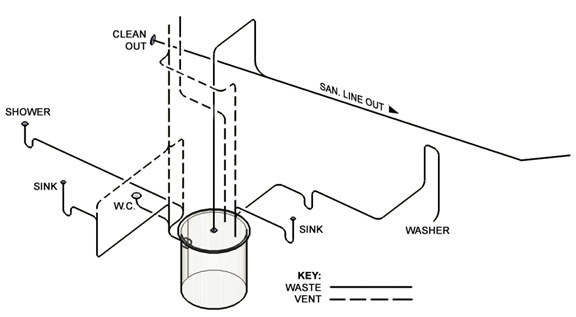

- Sewage ejector pump installation diagram how to#
- Sewage ejector pump installation diagram install#
- Sewage ejector pump installation diagram manual#
- Sewage ejector pump installation diagram code#
I am sure a number of you can think of more issues or questions that would need to be addressed with the reader.Operating instructions and parts manual *where codes permit, sewage pumps can be used for effluent systems. Proper sewer line placement, location and sizing of the sump or tank must be determined, and it may be necessary to insulate both the tank and piping.
Sewage ejector pump installation diagram install#
Concerns about odors are properly placed, and it may be necessary to install a carbon filter on the vent pipe to ensure there are no odors.Ī final thought is that in cold-weather areas such as where I live, consideration should be given to freezing risk. From the description, running the vent from the sump or tank up the side of one of the buildings would be the preferred route. The reader does recognize another important issue - the need to vent the pump and sewer line. A different location would seem to work better for pump placement. Another aspect to be considered is access to the pump for repair and maintenance if it is in a hard-to-reach location. Although this would be good from the standpoint of pumping distance to the sewer line, it doesn’t factor whether the sewer line can be installed with the proper slope to move the raw sewage 150 feet to the pump. Since he only has a 2-foot crawl space, I am not sure how he intends to install the sump and pump. One thing he mentions is putting the pump under the house. Elevation, size of the pipe, friction loss in the pipe and the necessary discharge rate will determine head requirements for the pump.

These conditions factor into not only the type of pump needed, but the size to deliver the proper amount of sewage over the required distance. The reader makes no mention about the size of the sump or tank the pump will be placed in, nor the size of the collection piping and any elevation changes that occur between the locations.
Sewage ejector pump installation diagram code#
First and foremost, what are the city code requirements to do this? As we know from experience, this will probably dictate his other decisions. But there are a lot of things to consider that I am unsure the reader has factored into his desire to install two bathrooms and hook them up to the city sewer. Also, I am concerned about the smell because the pump would be buried about 20 feet from my in-ground gunite pool.”įrom the description of the problem, it appears a sewage ejector pump would be the right choice.
Sewage ejector pump installation diagram how to#
Not sure how to vent I guess just run a vent pipe up the side of the building and through the roof? Just wanting to keep everything as clean as possible. Another thought was to put the grinder pump just outside the pool house near the bathroom, but I’m worried about the distance it will have to pump and the vent situation. I was thinking about putting the grinder pump under the house and venting to existing vents. My house has a crawl space with the plumbing about 24 inches off the ground that flows to the city sewer. With that introduction out of the way, here is the reader’s question: “I’m adding a bathroom in my shop, about 150 feet from my house, and a bathroom in a man cave/pool house between the shop and the house. A note here in the case of vertical lift: Depending on the specific application, either an ejector or grinder pump might be the proper choice. Applications where a sewage ejector pump should be used are when pumping sewage to a septic tank, when pumping sewage to a gravity sewer main, when pumping sewage short distances (750 feet or less) and when there is a low vertical distance to lift the sewage.Īpplications where a sewage grinder pump should be used include when pumping to a pressurized sewer main, when pumping a long distance (1,000 feet or more), and when there is a high vertical distance to lift the sewage (at least 30 feet). It is no different here where the application and resulting capacity and head requirements will determine which type of pump to use.įor most of the applications we encounter in our industry, the correct choice is a sewage ejector pump. This is determined by a combination of elevation difference from the pump to the delivery point and the friction loss in the supply pipe. I have usually discussed this in the context of pumping effluent to a pressure distribution system and making sure the pump has the right delivery capacity (gallons per minute) operating against the required dynamic head (feet). So what is the difference? The difference is in the desired application, and it relates back to previous columns on pumps where I emphasized that pumps are designed to do certain jobs and as a service provider it is important to pick the right pump for the job. Basically, both pumps are built to handle and pump raw sewage.


 0 kommentar(er)
0 kommentar(er)
